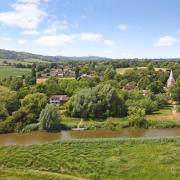As a new year begins, it is time to take a more holistic and sustainable approach to gardening and understanding the environment as we become increasingly aware of our impact on the planet. Achieving equilibrium in our landscape is beneficial to all as we continue the trend of the eco-conscious gardener, greening our outdoor spaces. By making tweaks to our own gardens, we can have an impact on the wider world. Unpredictable weather with periods of heat, drought, cold and wet are increasing because of the climate crisis so we need to adapt. But individuals can help protect against the increase of droughts, flooding and extremes of temperature with their plant and landscaping choices. There are drought-resistant and flood-resistant species as well as ones that soak up pollution and contribute to the health of the soil. So why not start in your home garden, then seek inspiration to garden more thoughtfully in an eco-friendly way that can also adapt to the vagaries of climate change?

We are more then ever selecting plants that are hardy, and also benefit wildlife and the wider environment. Gardening is one of the most visible and interactive ways people can improve their surroundings. The focus is on finding resilient plants that suit your soil and using more recycled materials in hard landscaping. Plan your garden for the long term by being conscious of your choices. Be guided by the lay of the land for drainage and shelter, grow more hardy trees and shrubs to lock up carbon, and provide a tiered ecosystem that reduces maintenance and pests. People are looking more towards natural and organic ways to control pests and diseases as they try to avoid harming bees, butterflies and other wildlife that have declined in recent years. During the last decade we have seen alarming acceleration in weather patterns: hot, dry, wet, and cold periods that no longer follow the seasons, which means there is increased pressure on the plants to perform.

More than ever it’s a case of right plant, right place, buying locally grown plants and using up-cycled items to reduce your carbon footprint. The Royal Horticultural Society believes that plants and their placement hold the key to mitigating some of our biggest environmental threats we face today. ‘With every new garden or planting we do through the RHS we expect to have an environmental benefit. This will gradually filter down to everyone,’ explains Guy Barter, chief horticulturalist. ‘Our science team is working on trees that are suitable for climate change, such as varieties of oak and ash. Other trends are planting more shrubs, less maintenance, introducing plants with low impact on soil and fertilisers, wildflower gardens, wildlife-friendly choices, and minimizing cultivation with the no-dig method. Priorities tend to be centred on lifestyle and justifying the expenditure – gardens that are good for us, good for our children and good for the planet.’.
As the climate changes we need to introduce species that are better adapted but are also non-invasive and not harbouring unwanted pests to protect our wider environment. Finding a broad palette of disease-resistant native and near-native species should be our aim. ‘Plants that can cope with a wider range of conditions will survive for longer. Cultivars that are resistant to pests and diseases help to future proof the garden. Resistance to climate change will be facilitated by choosing, for example specific tree species that can cope with extremes,’ explains Dr Marc Redmile-Gordon, Senior Scientist for Soil and Climate Change at the RHS. ‘A changing climate means expanding a little on what we consider to be native. There is evidence that natives, and ‘near’ natives are better for wildlife and biological resilience to climate change, in comparison to randomly selected ‘distant non-natives.’

Begin by looking at all aspects of your garden, such as the depth and type of soil, light levels, any damp or frost pockets, and how the water drains, before you add any new plants. ‘Effective drainage is the key to resolving winter wet. If areas are naturally very wet this can be a valuable feature for wildlife, and in this case select wetland or flood tolerant plants to minimise loss and expense,’ Marc advises. ‘People often have ‘go-to’ favourite plants but it is important to bear in mind that even favourites will not look good if they are in the wrong place.’
For inspiration take a visit to local gardens to see how they are adapting. Head Gardener Tom Brown at West Dean Gardens, for example, has found that an over reliance on buxus hedging and topiary has been a challenge, and they are looking at a more diverse plant community to help safeguard against climate change in the future. ‘We are moving away from Mediterranean plants, towards North American species which seem more tolerant of extreme wet and drought,’ he adds. Tom’s top five weather-proof plants are echinacea, rudbeckia, siliphium, canna and miscanthus.

Pauline and Paul McBride, who have created the stunning Sussex Prairie Garden in a naturalistic style, also recommend echinacea, along with rudbeckia, amonsia, hemerocallis, helenium, aster and ornamental grasses, such as miscanthus, molinia, and scented sporobolis. ‘We are trying to focus on a garden which is going to stand and deliver as a showcase garden and so there has to be a mix of plants with swagger and style that have a proven track record of performance in spite of the climatic conditions,’ they say. ‘Climate change is a challenging issue and we are closely looking at plants that will answer these climatic question.

Wakehurst, Kew’s country botanical garden, which is always innovative and houses the seed collection at the Millennium Seed Bank that is the most diverse wild species genetic resource in the world, is also worth a visit. They have recently been exploring plants they think will be around in 2050, as we are increasingly forced to rethink how we approach our green spaces – from hosepipe bans to mitigating floodwater. They asked scientists and horticulturists: ‘What will our gardens of the future look like?’ A planter is on display with some of their contenders, which include drought-tolerant European Marram grass, dwarf birch that uses the increased nitrogen to maximise the chlorophyll in its leaves, frangipani with its leathery leaves that can tolerate higher temperatures, and pest resistant common myrtle.

Get the look
• Increased variances from drought to floods mean that sometimes dry areas of your garden can be occasionally flooded and wet areas can have moisture deficits at times
• Few plants survive waterlogging or flooding so it’s helpful to improve drainage, the soil structure and have permeable hard surfaces. Manage water flow by creating rain gardens with water catchment areas of ponds, rills and channels.
• Plants need to cope with stronger winds – grow smaller or fastigiate trees or ones that are known to be resistant to wind damage. Low growing species are also more wind tolerant
• Grow less resilient plants in containers that you can move to shelter as needed
• Trees are vital for giving shade, storing carbon, filtering pollution, slowing heavy rainfall and drinking up water from intense storms
• Champion British-grown plants and look for companies that are environmentally aware in their production and packaging.
• Many modern garden practices release harmful greenhouse gases into the atmosphere, such as synthetic fertilisers and inefficiently heated greenhouses
• Make your own compost, mulch plants, collect rainwater, don’t water your lawn, reduce use of electricity, use solar lighting, environmentally-friendly or natural pest control, physical barriers, companion planting and sustainable fertilisers such as manure and seaweed.
• Include plenty of wildlife attracting plants such as flowers for pollinators. Aim to have nectar and pollen rich flowers for as long as possible throughout the year.

Key weather-proof plants
• Dry in summer, wet in winter – Betula utilis var, jacquemontii ‘Silver Shadow’, Malus, Geranium ‘Rozanne’, Hemerocallis
• Wet soils – Liquidambar styraciflua, Salix alba, Cornus alba, Hydrangea paniculata, Phyllostachys
• Diverse stress conditions - Buddleja davidii, Convallaria majalis, Cotoneaster horizontalis, Euonymus fortunei, Eupatorium, Euphorbia
• Garden stalwarts - Amelanchier, Berberis, Cotinus, Forsythia, Hypericum, Lavatera, Magnolia stellata, Philadelphus, Potentilla, Ribes, Sambucus, Spirea, Viburnum tinus and V. opulus, as well as climbers such as Clematis montana, Hedera, Lonicera, Parthenocissus and Solanum crispum
To know
• Look at the RHS website for garden worthy plants that cope with the irregular oscillation of wet and dry soils, as well as lists of trees for climate change. rhs.org.uk
• Wakehurst, nr Haywards Heath, RH17 6TN kew.org
• West Dean Gardens, PO18 0RX. Open through the year. westdean.ac.uk
• Sussex Prairies, Henfield, BN5 9AT. Opens from 1st June. sussexprairies.co.uk



























